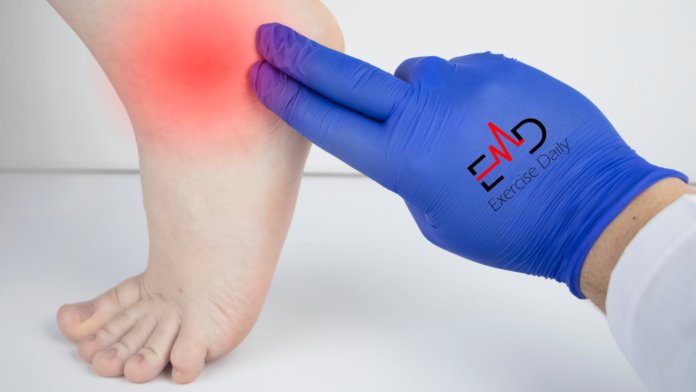Table of Contents
Exercise Daily – Want to know the heel spurs surgery recovery time? If so, then read this article to know everything about heel spurs.
Achilles heel spur surgery recovery time might vary depending on how the treatment worked. You should be up and walking in approximately 6 weeks.
Foot discomfort can result from a variety of factors, the most prevalent of which are heel spurs and plantar fasciitis.
When the pain becomes unbearable, and medicine and non-surgical methods fail to alleviate it, your doctor may prescribe surgery to relieve it.
Using this method, you can reduce discomfort, enhance your walking capacity, and increase your ability to participate in everyday activities.
What Is A Heel Spur?
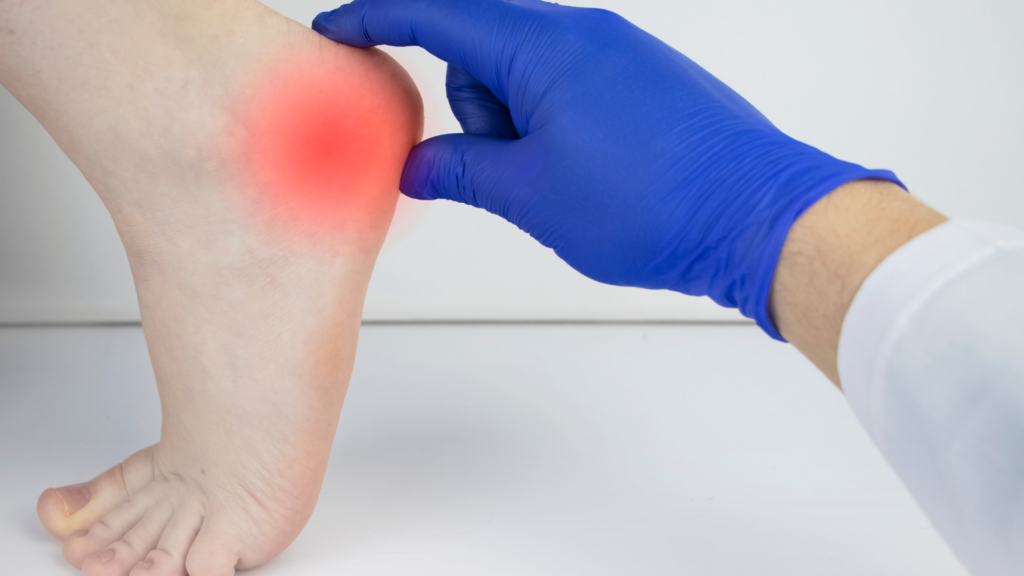
Known medically as a heel spur, this foot problem results from a bone-like protrusion, a calcium deposit, that grows between your heel bone and your arch.
Heel spurs are most commonly found at the front and underneath the heel of the foot. In the end, they will have an impact on other areas of your foot.
In certain cases, they might grow to be half an inch in length. They may or may not be apparent to the naked eye, depending on the situation.
Detecting heel spurs can be a difficult process. Heel spurs are not always painful, and not all heel discomfort may attribute to spurs as well. Continue reading to discover more about these bony growths and the factors that contribute to their formation.
What Are the Symptoms of Heel Spurs?
Before moving towards the heel spurs surgery recovery time, let’s talk about the symptoms of Heel Spurs. Heel spurs can cause a variety of symptoms, including:
- Pain
- Inflammation
- Swollen heel at the front part of it.
It is also possible that the afflicted region will feel warm to the touch. It is possible that these symptoms will extend to the arch of your foot. Once in a while, a tiny bony protrusion will become evident.
Some heel spurs may not manifest themselves with any symptoms at all. It is also possible that no changes appear in the soft tissues or bones around the heel.
Heel spurs are frequently detected only after X-rays and other testing have been performed for another foot problem.
What Are the Causes of Heel Spurs?
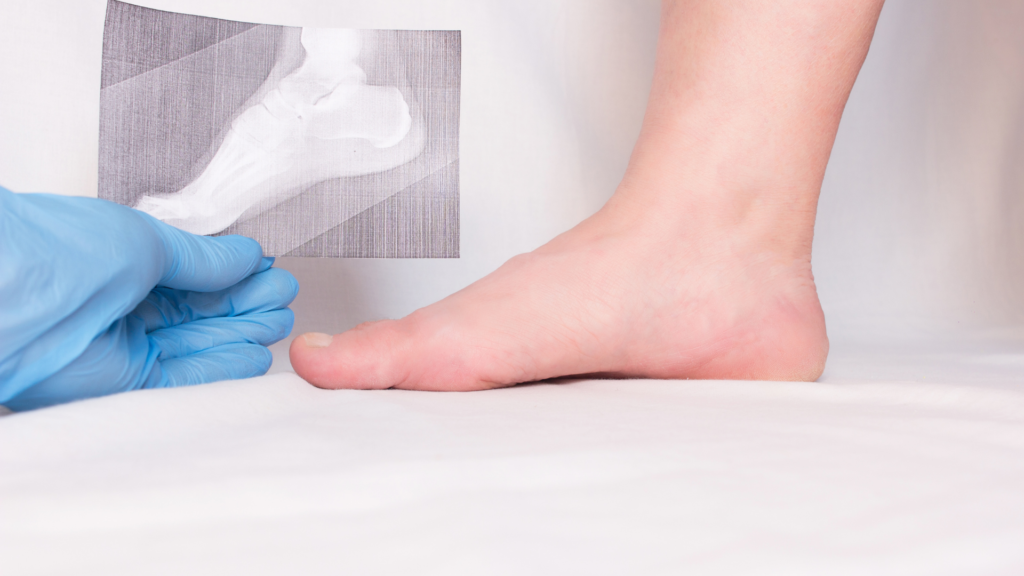
To begin, let’s talk about what causes these painful spurs in the first place. Afterward, we’ll talk about heel spur surgery.
Foot problems such as heel spurs are essentially just an accumulation of excess calcium deposits. That accumulate on and around the calcaneus, commonly known colloquially as the heel bone spur removal foot, over a lengthy period of time.
The development of these bony growths may cause other medical problems or circumstances in one’s daily life. Heel spurs, for example, might develop as a result of wearing shoes that are either too tight or thinly cushioned.
Individuals who are overweight or obese, as well as those who have arthritis or who have certain gait irregularities, such as overpronation, are at higher risk of developing heel bone spurs (also known as flat feet).
Moreover, the heel spurs surgery recovery time depends on the causes as well.
The strain placed on the bones and connective tissues of the foot as a result of activities such as running and jogging may also contribute to the development of heel bone spurs in certain individuals.
Histology has determined that heel spurs are produced by long-term muscle and ligament tension. In the long run, this excessive strain puts stress on the heel bone (calcaneus), resulting in spurs.
Heel spurs are a condition that develops over time. They do not appear as a result of an exercise or a sporting event on their own. Heel spurs are more likely to develop if you ignore early signs such as heel discomfort.
Heel spurs are a typical result of repetitive stress from activities such as walking, jogging, or leaping on hard surfaces. They can also develop as a result of wearing shoes that do not provide adequate support for your foot.
Possible Causes of Heel Spurs
Heel spurs can also be caused by the following:
- Arthritis
- Bruise on the bottom of the heel
- A surplus of bodily weight
- Tight shoes
- Problems with one’s walking gait
- Overusing flip-flops on a regular basis
- Damaged shoes
All the causes may affect the heel spurs surgery recovery time.
Many patients who have to heel spurs also have plantar fasciitis, which is a kind of foot inflammation.
This severe disease affects the strong, fibrous tissue that runs between your heel and toes and can be quite painful. When you have plantar fasciitis, you increase your chances of acquiring heel spurs in the future.
What Is the Best Way to Tell If You Have A Heel Spur?
There are a variety of common heel spur symptoms that can occur regardless of the underlying reason. Many people report that their heel spur pain is more severe first thing in the morning.
A sharp sensation along the bottom of the foot may be experienced by certain people who are suffering from it.
It is also possible to have minor heel spur discomfort that lasts throughout the day and is more noticeable during and after strenuous activity, such as running.
Besides inflammation and discomfort at the bottom of the foot, there are other symptoms of a foot bone spur.
It is possible that a noticeable protrusion will emerge where the spur has formed in the case of bigger bone spurs.
The type of treatment already undergone also plays an important role in heel spurs surgery recovery time.
For patients with mild to severe heel pain, a physical examination and/or additional diagnostic imaging is necessary in order to determine the underlying source of the problem.
It’s crucial to remember, however, that not all heel spurs will cause stiffness or pain in the affected foot.
According to the American Academy of Orthopedic Surgeons, only around 5 percent of people who have heel bone spurs will feel foot discomfort as a result of their condition.
Diagnosis of Heel Spurs

It is difficult for you to detect a heel spur without the aid of a medical professional. This is due to the fact that the symptoms are quite similar to those of other types of heel pain and foot issues.
In order to receive an accurate diagnosis, you’ll need to consult a specialist such as an orthopedic surgeon or a podiatrist.
An X-ray is then used to determine whether or not there is a heel spur. Most bony protrusions aren’t apparent to the naked eye because of their location.
That is why diagnostic imaging techniques are critical if you are suffering foot discomfort and inflammation due to an unknown reason.
During a physical examination of your foot, your doctor will search for any indications of redness or inflammation and then request imaging tests to rule out any serious problems.
Diagnosis is an important factor in heel spurs surgery recovery time.
Your doctor will also examine your foot to see if there is any obvious discomfort. Another sign of a heel spur is tenderness in the heel area.
Additionally, your podiatrist may ask you to participate in physical tests such as stepping solely on a single foot at a time and completing a short stroll.
Various Treatment Options for Heel Spurs
Once the issue has been correctly identified, your healthcare professional will prescribe the most effective heel bone spur therapy for your specific case of heel bone spurs.
In many cases, nonsurgical heel spur therapy can provide sufficient relief from bone spur discomfort without the need for surgical intervention.
According to the American Academy of Orthopedic Surgeons, “more than 90 percent of individuals with plantar fasciitis will recover within 10 months after beginning basic treatment methods” for the condition.
In many situations, therapeutic treatment will entail making changes to one’s way of life. Patients who are overweight may find that reducing extra pounds will assist in alleviating the tension placed on the afflicted foot and heel while participating in weight-bearing activities.
Depending on the severity and frequency of symptom flare-ups, it may be essential to modify the intensity and frequency of activities performed by athletes suffering from bone spur discomfort.
The type of treatment you are already taking may also decide the heel spurs surgery recovery time.
In certain cases, people suffering from lesser heel spur symptoms may be able to complete an acceptable heel spur treatment program at home, which would consist of rest, ice, compression, and elevation.
Also available to help with general pain and swelling after strenuous activities and during symptom flare-ups are nonsteroidal anti-inflammatory medications (NSAIDs).
The use of a regular stretching routine may be recommended as an alternative heel spur therapy at home since certain bone spur pain symptoms are connected with tight muscles and connective tissues in the foot and lower leg.
Simply putting the balls of your feet along the edge of a step while facing upwards and gently and securely lowering your heels will provide a simple calf stretch.
Stretching and Heel Spurs Treatment
Stretching while seated can also be accomplished by utilizing supportive bands to move the tops of the feet closer to the torso.
If a healthcare professional recommends more specific exercises to stretch the plantar fascia, these are generally most helpful when performed first thing in the morning before engaging in strenuous activities during the day.
It is also possible to employ night splints to keep the ligaments of the foot, especially the plantar fascia, relaxed throughout the nighttime hours.
Shoes that are properly fitted, heel cushions to cushion the bottom of the foot, and implants to reduce the effects of gait disorders (such as high arches or overpronation) may all be useful.
In order to relieve tension on the plantar fascia, several assistive devices and inserts may be used. This may also decide heel spurs surgery recovery time.
If the issue is severe, a healthcare professional may prescribe a comprehensive physical therapy plan that includes both stretches and other heel spur exercises to alleviate pain and suffering associated with the condition.
In these instances, a physical therapist will design a physical treatment program that is specific to the patient’s needs.
Once the patient is comfortable, these heel spur exercises for plantar fasciitis and heel spur pain can be practiced independently at home per the patient’s request. In addition, cortisone heel spur injections may be beneficial in reducing discomfort and swelling.
Although these injections will provide immediate relief from heel spur pain, it is crucial to remember that patients will need to return for cortisone heel spur injections throughout the year in order to get long-term improvements.
What Is Heel Spur Surgery and How Does It Work?
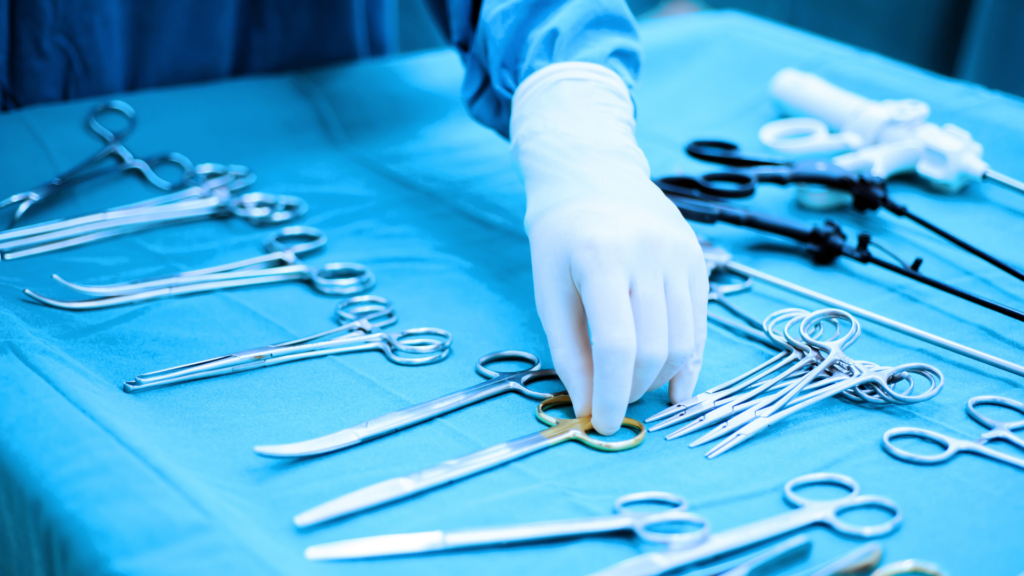
If nonsurgical treatment methods have failed to relieve a person’s heel spur discomfort, surgical intervention may be required to ease the pain.
Once your exact issue has been identified, your healthcare practitioner will review the many heel spur surgery choices available to you.
Heel spurs may develop in conjunction with other diseases, such as plantar fasciitis, which will have an impact on treatment options.
Known as plantar fasciitis, this condition is characterized by inflammation of the plantar fascia ligament, which runs down the bottom of the foot and can result in the formation of bone growths along the heel.
The discomfort associated with this sort of heel spur is frequently connected with the inflamed ligament that is causing the inflammation. If this is the case, your doctor may prescribe a treatment called plantar fascia release to alleviate your discomfort.
Here comes the surgery and heel spurs surgery recovery time.
A piece of the plantar fascia will be removed during a plantar fascia release operation in order to alleviate inflammation and discomfort. This treatment can be conducted as an endoscopic or open procedure, depending on your preference.
The endoscopic technique will require fewer incisions and will result in a faster recovery period than the traditional open operation. Your doctor will prescribe one of these treatments depending on the specifics of your medical condition and needs.
Heel spur removal surgery is sometimes required in rare situations. However, it is less common than the other treatments discussed above.
In most cases, your provider will only consider heel bone spur removal if all other choices for heel spur therapy have failed to provide symptom alleviation for you.
Heel Spurs Surgery Recovery Time

Most likely, patients would wear a bandage over the wound for up to two weeks following heel spur surgery. It is common for crutches to be used to aid with weight-bearing activities throughout the healing period following heel spur surgery.
Mild pain and discomfort can be alleviated with the use of over-the-counter pain relievers. In order to assist reduce pain and edema immediately following surgery, the RICE technique should be followed. Compression can be achieved by the use of bandages and wraps.
Maintaining an elevated position for the surgically treated foot (preferably above the heart) will also help to reduce edema.
While the majority of patients may expect a few weeks of recovery time following heel spur surgery. It may take as long as three months for certain individuals to achieve a full recovery after heel bone spur surgery.
First Week
The majority of patients suffer swelling and discomfort during the first few days, which subsides within a week or two in most instances.
It is recommended that you keep your standing and walking to a minimum during this period. If you put too much weight on your foot too soon after a foot injury, it might slow healing process.
Your doctor should be able to remove any stitches that have been applied within the first three to seven days.
First Two Weeks
During the heel spurs surgery recovery time, the majority of patients who work at desk occupations should be able to return to work within two weeks of their surgery.
Depending on how your heel feels, you may still need to apply cold compresses to it in order to minimize swelling and irritation. Your doctor may recommend that you keep your foot elevated during the day in order to speed up the healing process.
First Month
Patients who work in physically demanding occupations that entail a lot of walking and standing should be able to return to their employment after the first month of treatment.
In order to secure your safety at work, you will need to get clearance from your doctor before returning to work.
Patients should be able to move more easily and take care of their everyday requirements during this period. At this time, any scars should be disappearing and becoming considerably lighter in color.
Limitations of Heel Spurs Surgery
There are certain limits to Achilles bone spur surgery, despite the fact that it is successful for many patients.
Additionally, the surgeon may need to do additional operations on these individuals. Even if you have considerable improvement following bone spur surgery, for example, the spurs may reappear.
Seeing a physical therapist might assist improve the result of a surgical procedure in some cases.
Heel Spurs Surgery Recovery Time – FAQs
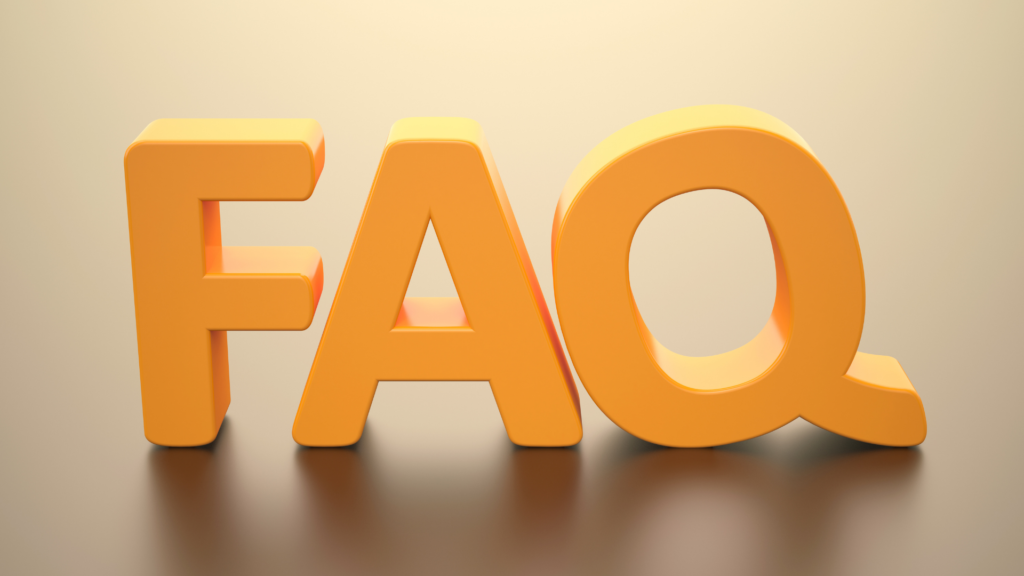
How long does it take to recover from foot bone spur surgery?
The majority of patients may expect a few weeks of recovery time following heel bone spur surgery. However, some individuals may require up to three months to achieve a full recovery following heel bone spur surgery.
Can you dissolve bone spurs?
The discomfort associated with bone spurs can be eased without the need for a scalpel to be used on your foot. A surgical procedure can be more disruptive than the presence of a bone spur in many cases.
How do you get rid of a heel spur?
Exercises, custom-made orthotics, anti-inflammatory medicines, and cortisone injections are all options for treating heel spurs. If non-surgical therapies are unsuccessful, surgery will definitely work.
What is the fastest way to heal a heel spur?
For 10 to 15 minutes at a time, apply an ice pack to the affected area of your foot. This is especially useful towards the end of a long day.
Moreover, surgery is another option that most people consider. But the heel spurs surgery recovery time may vary depending on the condition.
Alternatively, you may roll a frozen water bottle beneath your foot. This approach includes a small amount of massage, which helps to relieve stiffness in the bottom of your foot.
What doctor performs surgery on heel spurs?
Podiatrists and orthopedists are two types of medical experts that can diagnose and treat heel discomfort. Both have the capacity to conduct surgical procedures if necessary.
How to dissolve bone spurs with essential oils?
You can use essential oils like bergamot oil, thyme oil, lavender oil, rosemary oil, fennel oil, sesame oil, eucalyptus oil, and orange oil.
What is heel spur surgery?
Heel spur surgery comes in when non-surgical treatments fail to give enough relief. It is possible to have surgery done in two different ways.
One method is to target lower spurs on the bottom of the heel. While another is to target anterior spurs on the back of the heel.
How long after heel spur surgery can you walk?
A minimum of three weeks is usually required before the patient can walk normally and with just a little pain. Patients should return to using their orthotics when they are no longer uncomfortable in their shoes.
Can you walk after bone spur surgery?
Your foot will be wrapped following the procedure. However, it is frequently possible to walk on it immediately. In rare instances, you may need to wear a surgical shoe for a period of several weeks.
When is surgery needed for heel spurs?
In the majority of instances, you will see a reduction in pain within a few months after commencing nonsurgical therapy.
If your heel spur is big after 12 months of non-surgical therapy, you may be a candidate for surgical intervention. However, the heel spurs surgery recovery time may vary.
How successful is bone spur surgery?
In some cases, heel spur surgery is a success, but it is not successful in other cases. While some patients see a reduction in pain and suffering within a week of surgery. Others continue to experience chronic pain for several months after the treatment.
Even if surgery is successful, a heel spur may reappear in the future.
Will physical therapy help with Achilles bone spur?
Individuals suffering from Achilles tendinopathy can benefit from physical therapy services to alleviate discomfort in the afflicted area. Moreover, to restore strength, flexibility, and mobility to the damaged tendon and to minimize swelling if it is present.
What is a bone spur in the Achilles tendon?
The rear heel spur is a bony protrusion that develops where the Achilles tendon connects to the bone.
In this situation, you will have discomfort in the back of your heel. A rear (or posterior) heel spur develops as a result of excessive tension placed on the Achilles tendon.
How is the laser surgery on the foot spurs?
The K-Laser has been used effectively by the specialists at North Shore Foot & Ankle in recent years to treat patients with chronic heel pain.
Deep tissue penetrated by the laser is a safe and painless manner. The plantar fascia stimulates to recover using this non-invasive therapy method.


